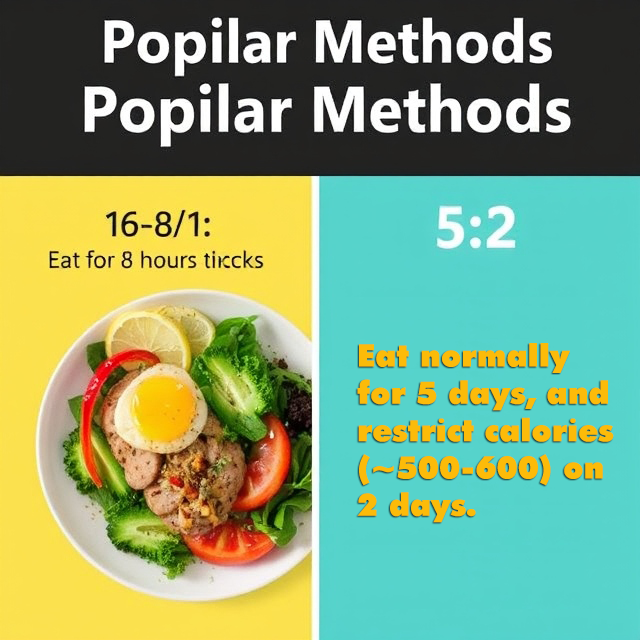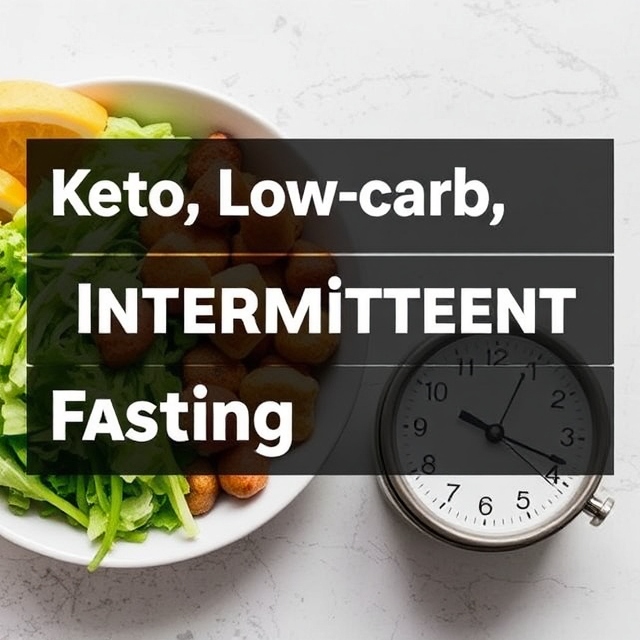Part 1: An Overview of Popular Weight Loss Methods
What Are Keto, Low-carb, and Intermittent Fasting?
- Keto: A ketogenic diet involves drastically reducing carbohydrate intake and replacing it with fat, leading the body into a metabolic state called ketosis.
- Low-carb: This diet restricts carbohydrates but allows moderate intake, focusing on whole foods like vegetables, fruits, and proteins.
- Intermittent Fasting (IF): This method doesn’t restrict specific foods but alternates between periods of eating and fasting. Common patterns include the 16/8 method (16 hours of fasting and 8 hours of eating) and the 5:2 method (eating normally for 5 days and restricting calories for 2 days).
Comparing Principles
- Keto: Prioritizes fat as the primary energy source.
- Low-carb: Limits carbs but includes more dietary flexibility.
- IF: Focuses on when you eat rather than what you eat.
Common Goals of These Methods
- Weight loss: Reducing body fat and achieving a healthy weight.
- Health improvement: Enhancing energy levels, stabilizing blood sugar, and reducing risks of chronic diseases.
Scientific Example: Research from The Lancet suggests that both keto and low-carb diets can effectively reduce abdominal fat, while IF has shown potential in improving insulin sensitivity and lowering inflammation.
Part 2: Detailed Comparison of Each Method
Keto
How It Works
By severely limiting carbs (to about 5–10% of daily intake), the body enters ketosis, burning fat for energy instead of glucose.

Typical Meals
- Breakfast: Scrambled eggs with avocado and spinach.
- Lunch: Grilled chicken with leafy greens and olive oil.
- Dinner: Salmon with zucchini noodles.
Pros
- Rapid weight loss due to fat-burning.
- Effective appetite control.
Cons
- Hard to sustain long-term.
- Initial side effects like fatigue (“keto flu”).
- Nutrient deficiencies if not well-planned.
Scientific Example: A study in Obesity Reviews found that the ketogenic diet was associated with rapid weight loss but highlighted challenges in adherence over extended periods.
Low-carb

How It Works
This diet reduces carbohydrate intake but includes moderate amounts (around 20–30% of daily intake). Proteins, healthy fats, and fiber-rich foods are emphasized.
Typical Meals
- Breakfast: Oatmeal with berries and chia seeds.
- Lunch: Grilled fish with quinoa and steamed broccoli.
- Dinner: Beef stir-fry with bell peppers and mushrooms.
Pros
- Easier to follow than keto.
- Balanced and sustainable for many.
Cons
- Requires meal planning to avoid overconsumption of carbs.
- May lead to slower weight loss compared to keto.
Scientific Example: A meta-analysis in Nutrients revealed that low-carb diets consistently supported steady weight loss and improved cardiovascular markers compared to low-fat diets.
Intermittent Fasting

How It Works
IF involves cycling between eating and fasting periods, triggering processes like autophagy (cellular repair) and enhanced fat oxidation.

Popular Methods
- 16/8: Eat for 8 hours, fast for 16 hours.
- 5:2: Eat normally for 5 days, and restrict calories (~500-600) on 2 days.
Typical Schedule
- 16/8: Skip breakfast, eat lunch at noon and dinner by 8 PM.
Pros
- Simple and flexible.
- Boosts metabolism and may enhance brain health.
Cons
- Challenging for people with medical conditions or irregular schedules.
- Hunger and fatigue during fasting periods.
Scientific Example: A study in Cell Metabolism showed that IF improved metabolic markers and supported fat loss, particularly in those with obesity.
Part 3: Which Method Is Right for You?
Evaluate Your Goals and Lifestyle

- Do you want rapid weight loss? Keto may be effective.
- Do you prefer flexibility in food choices? Low-carb is easier to maintain.
- Do you prefer simplicity in meal planning? IF might suit your routine.
Comparing Key Factors
| Criteria | Keto | Low-carb | IF |
|---|---|---|---|
| Speed of Weight Loss | Fast | Moderate | Moderate |
| Sustainability | Low | High | High |
| Health Benefits | High (short term) | High | High |
| Meal Planning Effort | High | Moderate | Low |
Example: If you have a busy lifestyle, IF might be the easiest to follow. However, if you’re looking to manage blood sugar issues, low-carb might be better.
Part 4: Important Considerations

Balanced Nutrition
- Ensure adequate protein, healthy fats, vitamins, and minerals.
- Avoid extreme diets that cut out essential nutrients.
Exercise
- Regular physical activity complements any diet, boosting weight loss and overall health.
Listen to Your Body
- Adjust based on energy levels, hunger cues, and health markers.
Consult Experts
- Seek advice from a doctor or nutritionist, especially if you have underlying health conditions.
Each method—keto, low-carb, and intermittent fasting—has unique benefits and drawbacks. The key is to choose a plan that aligns with your goals, lifestyle, and health needs.
Final Advice:

- Focus on sustainability and balance.
- Incorporate a variety of nutrient-dense foods.
- Combine your chosen diet with regular exercise for optimal results.
Ultimately, the best method is the one you can maintain as part of a long-term, healthy lifestyle.



